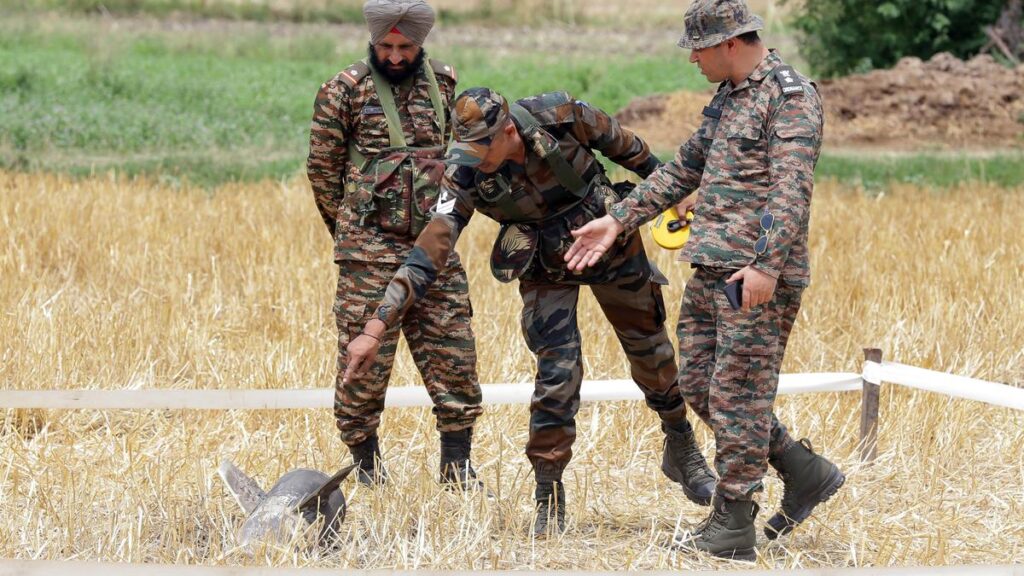
Army personnel examine the remains of a projectile discovered in Makhanwindi village near Amritsar, Punjab on May 8, 2025.
| Photo Credit: ANI
The Government on Friday (May 9, 2025) said on record that Pakistan has launched 300-400 drones, likely Songar Drones by Asisguard of Turkey, across the western border and a number of them were shot down by Indian air defences. Army Air Defence guns firing air burst ammunition intercepted the small drones. The overall air defences across the Indian air space are monitored and controlled by the Indian Air Force’s (IAF) Integrated Aerial Command and Control Systems (IACCS) nodes at various locations.
Informed sources, however, said over 500 drones, mostly quadcopters, were sighted in three waves in 36 places across the western border on Thursday (May 8) night between 8 p.m. to 11:30-12 a.m. “Majority were small quad copters which don’t show up on most radars, except the low level lightweight radar which has been calibrated to detect them,” a source said.

Meanwhile, the retaliation included a calibrated response which included Long Range Loitering Munitions, including the Harop and the Harpy, the result of which was seen on television yesterday, sources said.
Songar drones are armed Quadcopters developed by Asisguard of Turkey with a 3-km operational radius. And countering them were air defence guns – L-70, Zu-23 and Shikla – all of which have been upgraded recently and can fire air burst ammunition, which is effective in taking down small drones.
Also read | India hits back after intercepting Pak strikes
For instance, the L-70s have been upgraded recently by optical sights and hydraulic systems by Bharat Electronics Limited (BEL). Air burst rounds burst close to a target but don’t hit them. This makes them highly effective in taking down a swarm of drones.
Air Defence networks function in layers and at three levels – gun/missile system, medium range and long range. At the longest range is the S-400 with a range of 400 km, followed by the MRSAM (Medium Range SAM) with a range of around 70 km, Akash (25 km), Israeli Syyder SAM (around 10 km), and then legacy systems such as the Osa-AK and Tunguska systems. After this are shoulder-fired very short range systems like the Igla-S as well as the Strela-mounted systems.

Air burst ammunition, laser and microwave weapons, and smart ammunition are in various stages of procurement. While upgradation of high-end air defence systems is ongoing, equipping existing L-70 and Zu-23 air defence guns with air burst ammunition has been identified as a priority from the lessons of the Ukraine war. A tender has already been floated for 30mm fragmentation ammunition for the existing vintage guns.
The Army has already issued a Request For Proposal for a successor gun to replace the L70 and Zu-23 for 220 guns along with smart ammunition. Trials are expected to commence this July and the contract is likely to be signed by May-June 2026, Director General of Army Air Defence Lt Gen Sumer Ivan D’Cunha had said recently while adding that they are not looking to import any guns. “Smart ammunition is the next level. Every round can be programmed. 17 rounds of High Explosive rounds can be roughly equated to one round of smart ammunition. It increases kill probability and reduces logistics,” he had stated.
With the heightened threat of drones in both conventional and non-conventional conflicts, the Army had issued a Request For Information in January 2025 for 23 mm ammunition for its Zu-23mm and Schilka air defence weapon systems in service. The Army is also looking to procure air burst rounds for its 30mm cannons on infantry combat vehicles to counter drone threats to its armoured regiments.
The Indian Air Force (IAF) is responsible for looking after the air defence of the country. The IAF has set up Integrated Air Command and Control System (IACCS) nodes across the country, which act as crucial nerve centres monitoring the entire air space and communicating with various layers involved – radars, satellites, ground stations and firing units among others. In case of an incoming aerial threat, the IACCS nodes at handling the concerned location accesses the targets and assigns the particular air defence system suitable to take down the incoming targets.
Published – May 10, 2025 04:37 am IST
Source:https://www.thehindu.com/news/national/recently-upgraded-air-defence-guns-take-down-pak-drones/article69558659.ece

